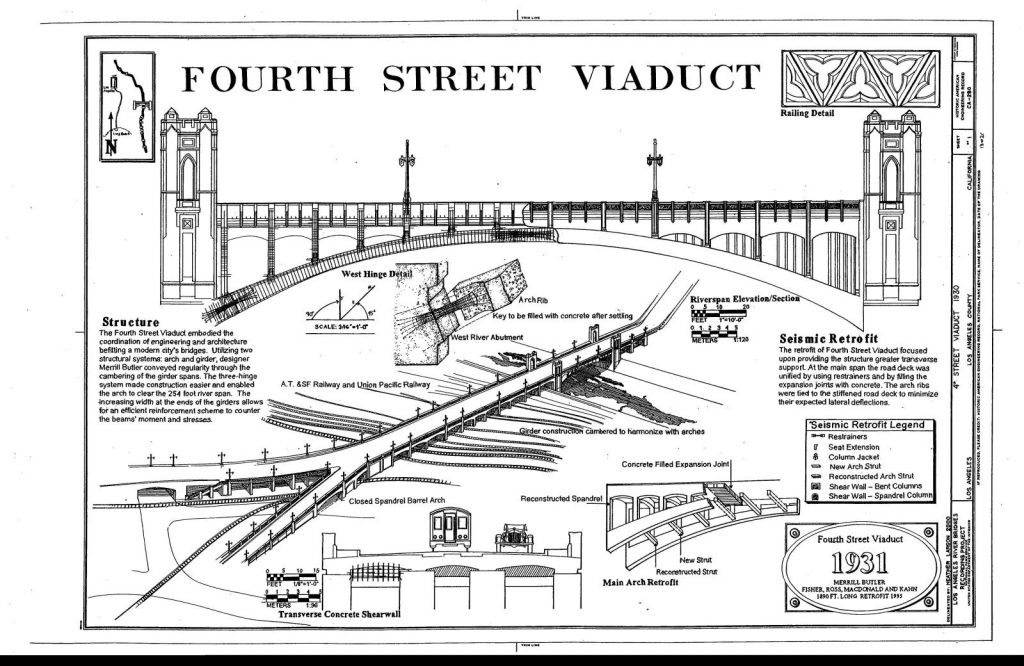Washington Blvd bridge

https://bridgehunter.com/ca/los-angeles/bh36678/
HistoryBuilt 1931
Design
Concrete tee beam
Dimensions
Length of largest span: 62.0 ft.
Total length: 312.0 ft.
Deck width: 56.1 ft.
Olympic Blvd Bridge

https://bridgehunter.com/ca/los-angeles/53C0163/
Built 1925
Open-spandrel concrete arch
Length of largest span: 99.7 ft.
Total length: 1,422.0 ft.
Deck width: 56.4 ft.
Recognition
olympic ave was renamed from 10th street for the 1932 olympics.
Bridge has olympic torches as part of it’s design.
7th street Bridge
 http://bridgehunter.com/ca/los-angeles/53C1321/
http://bridgehunter.com/ca/los-angeles/53C1321/
History
Built 1910, Second Deck added 1927, Seismic Retrofit 1995
Builders
– Lang & Bergstrom
– Merrill Butler
Railroads
– Los Angeles Railway (LARy)
– Los Angeles Transit Lines (LATL)
– Streetcar
Design
Closed-spandrel concrete arch
Dimensions
Length of largest span: 91.9 ft.
Total length: 1,000.0 ft.
Deck width: 56.1 ft.
This bridge was built in two stages. In 1910 the lower level was built at grade to allow trolleys across the river, which was unlined and much lower than now due to the LA River being on open quarry for aggregate mining. In in mid-1920’s it was decided to raise the bridge above grade as the trolley and automobile traffic was at 90o to the freight traffic going north south. Rather than demolish the bridge, they simply built on top of the existing bridge. The second deck is above the first and the same columns were used. Despite appearances, it is not a true double decked bridge as the lower deck is not connected to either bank. All traffic goes on the top deck.
6th Street Bridge
4th Street Viaduct

http://bridgehunter.com/ca/los-angeles/53C0331/
Built 1928
Design
Open-spandrel concrete arch
Dimensions
Length of largest span: 88.9 ft.
Total length: 390.1 ft.
1st Street Bridge

http://bridgehunter.com/ca/los-angeles/53C1166/
History
Built 1929
Builders
– Henry G. Parker (City Engineer)
– Merrill Butler
– Mittry Brothers Construction Co.
Railroads
– Los Angeles Railway (LARy)
– Los Angeles Transit Lines (LATL)
– Streetcar
Design
Open-spandrel concrete arch
Dimensions
Length of largest span: 148.0 ft.
Total length: 1,327.2 ft.
Cesar Chavez Avenue Bridge
http://bridgehunter.com/ca/los-angeles/530130/
History
Bult before 1875, Replaced in 1926; Seismic Upgrade 1995
Builder
– Merrill Butler
Railroads
– Interurban
– Los Angeles Railway (LARy)
– Los Angeles Transit Lines (LATL)
– Pacific Electric Railway (PE)
– Streetcar
Design
Open spandrel concrete arch
Dimensions
Length of largest span: 240.2 ft.
Total length: 1,027.0 ft.
Deck width: 56.1 ft.
North Main Street Bridge

http://bridgehunter.com/ca/los-angeles/53C1010/
Built 1910
Builders
– Carl Leonardt
– H.G. Parker
– T. T. Polich & Associates (2010 Upgrade Contractor)
Design
Open-spandrel concrete arch
Dimensions
Length of largest span: 97.1 ft.
Total length: 299.9 ft.
Deck width: 56.1 ft.
North Spring Street Bridge

http://bridgehunter.com/ca/los-angeles/53C0859/
Future prospects
The city’s Bureau of Engineering (BOE) is rushing to approve a project that would dramatically widen the North Spring Street Viaduct — nearly doubling its width, stripping away all historic ornamentation, and eliminating the bridge’s eligibility as a city landmark.
Built 1928; Rehabilitated 1939; Seismic upgrade 1992
Builders
– John C. Shaw
– Western Construction Co.
Design
Open-spandrel concrete arch
Dimensions
Length of largest span: 146.0 ft.
Total length: 682.1 ft.
Deck width: 39.7 ft.
North Broadway Viaduct

http://bridgehunter.com/ca/los-angeles/53C0545/
Built 1909; rehabilitated 1974
Builder
– Homer Hamlin
Railroads
– Los Angeles Railway (LARy)
– Streetcar
Design
Open-spandrel concrete arch
Dimensions
Length of largest span: 130.9 ft.
Total length: 866.2 ft.
Deck width: 56.1 ft.
Merrill Butler
http://articles.latimes.com/2000/oct/08/magazine/tm-33536
The bridges–1st Street, 4th Street, 6th Street, 7th Street, 9th Street, Spring Street, Cesar E. Chavez Boulevard (formerly Macy Street), Olympic Boulevard and (Washington blvd) were built to relieve congestion at the river, where pedestrian, automobile and trolley traffic intersected with copious railroad activity. The new spans replaced ugly, rusting, but easily manufactured iron-truss structures.
MERRILL BUTLER WAS BORN IN UPSTATE NEW YORK AND GRADUATED from the old Los Angeles Polytechnic High School downtown. He never went to college, but learned civil engineering via correspondence courses.


